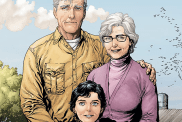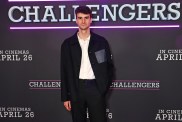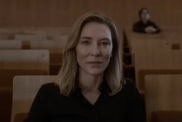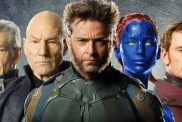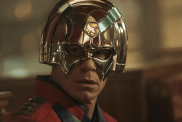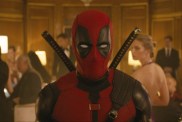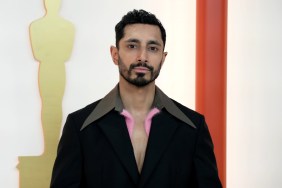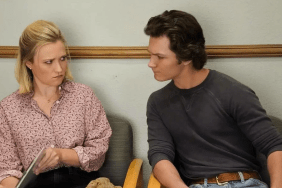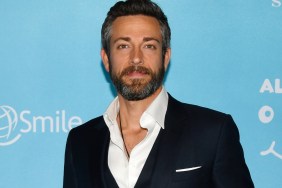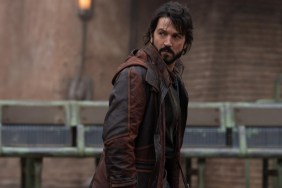In Part II of our Sky Captain and the World of Tomorrow set visit (read Part I here), ComingSoon.net talks in-depth to producer Jon Avnet about the Paramount film hitting theaters on June 25. Here is the full interview which took place at the production facilities in Van Nuys, CA last week:
We asked Jon Avnet to tell us the history behind the project.
She brought me this six minute presentation that Kerry had been working on for four years and basically what it was was his attempt to do a movie by incorporating techniques of animation that he had learned when he was at Cal Arts. I thought it was a really fascinating piece of film. It was shot all digitally. It was shot all on blue screen and he manipulated on his Apple computer literally in his garage and he created these images. You saw the shots. It was on that level of design that I thought was quite impressive and I asked him what he wanted the story to be and he told me roughly what it was and I said, “O.K., let’s try and do it.” I had sort of dipped my toe in the water doing some low budget films with first time directors. I was getting bored producing studio movies. I had done a lot of movies at Disney that I wasn’t wild about. They were successful. Some of them were fun, and as a producer, I just looked for something where you break a talent like what I did with “Risky Business” with Paul Brickman on his first movie, which I did find stimulating and exciting. So I refinanced the script. We talked about tone for about three days, that was the most important thing, and then we spent about two years working on the script. Essentially Kerry was a little more boys with toys kind of person and I was kind of more relationship oriented and we kind of merged the two. And much to my surprise, I don’t know, eight or ten drafts, a lot of drafts over a long period of time, we had a script that I thought was quite good.
And at that point, he wanted to shoot a movie of the whole thing, everything on high definition, everything on blue screen and do everything in house composited the way he wanted to do it to create a kind of look. Initially he wanted to actually do it in black and white. I was not interested in doing it black and white because I thought it was kind of artsy and even though the images were very nice, I thought it would be a lot more bold to actually see if we could come up with some sort of color that worked for that period and gave it a feel. And sometimes I do tend to like black and white. It’s getting a little easier in a certain way. I said, “Can we do it?” and Kerry thought he could and then we did some tests over a period of time and it started looking good. So the notion was he would shoot the entire movie before he went with our actors, blue screen with basically extras and storyboard what he was going to shoot and then cut them in a kind of crude animatics of the entire movie. So in effect storyboarding would be kind of shooting before we put any actors in and he did it. As he was doing that, I had confidence that this was something that I found very interesting. And of course, there are a lot of people who said the same words and are now working in Nova Scotia and maybe I was going to be one of them but I really was excited by the prospect of this and I thought the script actually demonstrated what the film was with the visual demonstration.
Where as he wanted to do it as a very small film, I thought well, why don’t we try and get really great actors, because usually with all due respect, a lot of these big movies tend to either have new actors or they’re trying to get actors who are really refined actors and maybe we could break someone or break them into a different world and I thought I might be able to attract them because I’ve worked with a lot of major talent, I’ve worked with a lot of young talent and I think my record is good so we went off and approached Jude. I thought that Jude was one of the truly bright lights of the film and theater world as a performer. He’s just incredibly talented as an actor and he also hadn’t broke as a big star quite yet. He certainly wasn’t an action star and in terms of the tone of the piece, which was a little bit like “Raiders of the Lost Ark” where you had this relationship, you’ve got this banter, he could do that easily. I thought you could possibly create the great relationship, something that you’d watch. And for me, if Kerry was successful, if we were successful, it would be something that was just fun and no pretense to anything other than having a really good time. You sat there and you went on a little bit of a rollercoaster ride and then you had some relationship, it was just enjoyable. Because so often movies, even the big commercial movies are ponderous and they get into deep philosophical stuff, which is fine.
How did the actors react to doing a whole film with blue screen, were they eager?
Yes, particularly Jude and Gwyneth, who we spent the most time with. When I met with Jude the first time, I showed him the presentation, I gave him the script and then when he said he was interested, we sat down and talked for a long time and I explained to him Kerry doesn’t talk. He’s very shy. He’s not the leather jacket cop out there saying look at me. He’d prefer to work for ten years and then look at the work. He’s very self depreciating. He’s quite talented. If he actually does become social, he’s very witty and good on his feet, he just doesn’t abuse that quality. I met with Jude. He was interested. He was excited by it. He was excited by this whole cockeyed process, as opposed to afraid if it or concerned. And then we turned to who would be the woman, and I had met Gwyneth before she became Gwyneth and I always thought she was pretty good as well and I thought the two of them would work in period. Some actors in my opinion, you put them in a period film and you all go, ehh. I thought they would work in that. I thought they would look stunning and I thought within the limits of my taste and my judgment that it could actually be quite cool. Also this is a movie by a nerd for nerds that just happens to be accessible to normal people. The revenge of the nerds in my opinion is over. The nerds have won when you think about our world. And this is not nerd friendly. This is nerd. Right now with the teaser and everything, it’s going to heat into a big deal but it’s of that world, as Lucas was when he started with “Star Wars” and then you get someone like Zemeckis who is technically gifted but not really a nerd. He just makes the nerds happy.
So we went to Gwyneth and she and Jude had worked together on “Ripley” and knew each other and we showed her the tape and she was really excited. She wanted to work with Jude and she wanted to sign on based on the presentation and I said you have to read the script, because I didn’t want her to be on it and not know what she was playing. But she was very enthusiastic and she did sign on. And then the problem began that I started to run out of money because I was financing all the computer stuff and all that stuff myself and I’m not a studio and I’m not vastly rich and so I had to make a decision to go to a studio or see if I could get independent financing and I was afraid that Kerry was just too idiosyncratic, that he had to be protected as long as you could protect him, otherwise it would become a homogonous piece. It would be like everything else. So the problem was who would allow me to do that, because we had had some interest from studios. And so I didn’t go that route and instead went to Aurelia DeLaurentis who was interested and agreed to finance it without a distribution deal. That was remarkable. And so we actually set the date, went to work, did eight or ten months prep before we went to London to shoot. We started shooting sometime near the end of February 2003. And meanwhile we had been shooting plates. We had been shooting all around the world, all sorts of other stuff that we fed into the computer while we were doing animatics and then our good fortune was that the shoot went well. I put together a presentation which was largely what you saw and then after shooting went to the studios, all of them on the same day, which I think might have been pretty unusual. Basically because of Aurelia’s backing, we said here’s what we want. There were multiple studios interested and had an arrangement set up and basically we were allowed to protect Kerry’s vision as much as anybody could. It’s very unusual.
Why did you choose Paramount Pictures?
There were a bunch of studios that were interested. Paramount was very interested. We felt, one, they wanted it. Sherry was very persuasive. There were other studios that could have done it. There were a couple studios that were very interested as well, but I thought it might be a good fit. I thought this might be really important to them and I think it is and that’s helpful in terms of marketing, marketing dollars, attention. And again for something like this, how do you market it? Do you turn it into the same thing everything else is? It’s unique.
Have you had to make any compromises?
I don’t know. We’re still cruising away here in neverland.

Wasn’t it originally called “The World of Tomorrow”?
Yeah. We had a conflict with the Fox movie, “The Day After Tomorrow,” and we could have done it if we changed the date that Paramount wanted to go, but I think no one wanted to have an issue with that title because that’s a big Roland Emmerich movie. There’s too much confusion there. And the original title was “Sky Captain and the Flying Legion and the World of Tomorrow” and having a penchant for long titles having done “Fried Green Tomatoes at the Whistlestop Café,” which got contracted to “Fried Green Tomatoes,” I didn’t mind “Sky Captain and the World of Tomorrow.
Can you talk about the casting of Angelina Jolie?
She was unemployed for a week, two weeks. You saw her in the presentation? How many people do you think could pull off that look. And I was dubious by the way that the look would work with the eyepatch. I do think it does. When we talked about it over the phone and then when I went to London to see her, she put it on. It didn’t quite work I thought at the time and then she redid it with the costume people and put it back on and then I went, “Son of a b*tch.”
Did Kerry have a lot of the concepts, like the robots and the planes, complete when you saw it?
When we first saw it, there were robots. There weren’t flying wings in the six minute presentation. Kerry will have worked on this thing for ten years. I mean, this is his life. He had a lot of these elements. He’s discarded and come back to them. He’s fairly monastic in terms of his approach to the film.
Were you consciously modeling the movie after serials of the past?
Well, the serials of the past were an influence. This is sort of Buck Rogers. So the serials had cliffhangers and that’s what this is. The reason that I mentioned that we spent three days talking about tone is it’s everything. If you can do these things, which not many people can do, you can still fail in my opinion if it’s too stupid, if it’s going for the cheap joke. By the way, you can succeed also, but maybe it’s not worth succeeding and what is success? There was a certain way of presenting it where it was sort of tossed off in the tradition of the Hawks movies. This is not camp. For film lovers, there are a lot of references in there that will go by pretty quickly and there are definite elements of homage, but they’re not done in a way to say, “Oh, look at this as a homage.” It’s in the thirties and the music of the thirties, the costume of the thirties. We like the retro. We like the art deco. Kevin, Kerry’s brother, designed the movie with Kerry.
Are you in the franchise business?
Initially, I thought we were going to do a series of these things and I believe it has a good chance to be successful and obviously if it is, there’ll be a demand for it. I’m not certain at this very moment only because I’m tired and I think I’m going to go and direct a movie after this. It’s taken a lot more time than I ever imagined. You fall in love with these things for good and for bad, Unlike marriage, there’s no divorce here. You gotta go through it.
We asked Avnet to talk more about the tone of the film.
You saw enough to get a sense. Like when Frankie is introduced, there’s a relationship obviously. There’s a past there. It’s not kitchy. It’s fairly straightforward. There’s a mystery that they’re trying to solve, and there’s a series of cliffhangers. I don’t think it’s campy. I think it’s meant to just enjoy and if we could emulate some of the great storytelling of those thirties movies, like Hawks and “His Girl Friday” and “Only Angels Have Wings.” Really just unbelievable movies that a lot of the kids who are a primary audience after the quote nerds who maybe haven’t been exposed to them.
Are you using original music?
We’re going to create our original music. We’re recording it in London.
Were the bluescreens done in London?
Yeah. It started out back there where you saw 40 or 50 nerds at work. That was our bluescreen and we had the plane there and we shot as I said the entire movie. Then we shot it with the actors and when we shot it, they could see the animatics of where they could and couldn’t move and what the shot was. They had embraced it. It’s in a way for a director a very sophisticated challenge. I’m speaking as a director. Getting a sense of pace, getting a sense of texture, getting a sense of the appropriate dramatic intensity as a director for the actors. It’s demanding because there’s nothing there. You could look at the animatic and you can show it to the actors but things can be flat. And by the way, there are times when they were. There were times when they had to be redone and that stuff does happen, so I don’t want to in any way give short shift to that question. This is a version of the virtual studio. This is unquestionably a wave of the future. Whether it’s going to be like this exactly or not, I don’t know but I can tell you there will be a leap in bluescreen work and compositing no matter what, and this is one way of doing it. What for me is extremely unusual and again you can judge it from seeing it in hi def, it looks like film. When you see it on film, it looks like film. That I have not seen. You can look at Rodriquez’ movie. You can look at other things that are shot on hi def. They have a different look. This mimics films quality. That will happen no matter what simply by ones and zeros that are available on computers. You’ll be able to hit, “I want to do Technicolor three strip,” “I want to do ‘Ben Hur.'” That will happen. That will be available. Here this is the first that I’ve seen where you can do film in effect on video and as such that’s a big deal. Now, if the film stinks, who cares! If you’re a film historian and you do care about these things, then you care on that level. It’s not going to entertain anybody. It’ll get a lot of talk because in a sense, it’s saying to anybody in your little computer, you can make a movie. You can actually design a movie and that is good.
How was Kerry at directing the actors?
Well, it took a little while for him to say action out loud. He was a quick learner. I think he acquitted himself well. It took a while. I mean, what I was doing was using my experience and my relationships to give it to him. For instance, we had a rehearsal in June about nine months before we started shooting. We did two things. We read the entire script and we used that for the animatics and the pacing, and then we rehearsed. In the initial rehearsals, he was kind of quiet but as they progressed a couple days, he got more active. I think if you asked him right now, he would tell you that he could do better and he would like another chance to do better. And he’s not coming from the theater having worked with actors, but he acquitted himself pretty damn well. And remember on a first film, sometimes there’s just magic and for whatever reason that is, the film God shines on it. As Caleb Deshanel said once, one of the most profound things I’ve heard about film, the most amazing thing about film is how forgiving it is. You make all these mistakes, all these compromises and sometimes you end up with “The Godfather.”
How different is this from what George Lucas has done with Episode I & II?
A number of things. One, the process by which we do it is different. Number two, you judge the look. You look at what Lucas has been shooting in hi def, you tell me whether it looks like film or not, and he’s shooting on hi def and is releasing digital. Right now, we’re releasing on film. It’s not that I have anything against the digital release, but even if we release it digitally, our goal is to make it look like film, basically a version of the three strip Technicolor process, which I like. It’s a matter of ascetics but I like this ascetic.

How do actors deal with being in something so planned out?
We talked with some actors who will remain nameless who have done this in other situations and one of the things that I, in talking with Jude and in talking with Gwyneth and then talking with Kerry because Kerry had spent time with them, I said, “Look, you’ve got great actors. Don’t hamstring them. Give them some freedom.” So as designed as it was, I kept pushing for freedom for invention. Jude is just so inventive. He’s a jewel. So he was very good. Gwyneth shows up, knows her work, knows her lines, has a real sense of the truth and an enormous ability to vary her performance but consistent with the character and within the context. So we used that dynamic as much as possible. We tried to learn from people saying when a director says, “Stand like this for three seconds and then turn, put your hand
over here on your head and look right at that.” Well, it’s difficult to make a performance alive if that’s what you have to do. So if you’ve got to look over there, the difference is you’ve got to look over there and then turn and look at that, and one looks real and one doesn’t, and those are the problems you encounter. And by the way, you encounter it all the time. It is endemic to this way of producing and it will in different people’s hands create different results. And I bet if you saw twenty films, you’d say, “I don’t like it because of this that and the other,” because of the gap in some of the performances and then you’d find performers who just knock it out of the park because they can.
Is it hard to stay in the movie and not get wrapped up in the design?
I’d say the biggest challenge to me is to remember the film. All this stuff is really exciting, but if the film doesn’t work, who cares? If the pace is slow, it’s boring, that can be the result. You look at it and what happens is you finish later than you finish a film so they’ll be able to screen it, look at it with an audience, get a sense of that is a little more difficult. The good part is you see the film much earlier, even though it’s not entirely finished, so you get a feel for what you’ve been doing. That balance is something I can’t speak to because I haven’t finished it, but right now we’re in the process of trimming stuff and pacing certain things up, doing things that are beginning to mimic my experience as a film director.
How many days did you shoot with the actors?
With principles? I’d say close to about nine weeks in total. We shot with other actors, we shot with stunt people and there’s a lot of shooting with additional people and then there’s motion capture. There are traditional elements and effects we use, so we scan them in and we can use them in certain shots. There are some pretty bizarre things that you can do now.
Have you made Kerry a more human filmmaker while he’s drawn into the realm of what’s possible?
Unfortunately yes on my part. I think there’s some truth to it. I sort of rankle a little bit the idea of making him more of a human filmmaker, but certainly I was more interested in the relationship and I did influence him in that direction, but Kerry’s very talented.
How did you get a spontaneous feel to the camera movement for a storyboarded movie?
Some of that was my job. Kerry did the movie in November. Four or five months before we started shooting, he showed me the movie. I had seen bits and pieces of it. I said, “I don’t like this,” “This is too slow, let’s do more here,” so he did stuff. That has a big advantage. The disadvantage is some things I couldn’t tell were there, so there was a certain amount of guesswork, so I did the best I can. There were certain things that I would. I think I wasn’t tough enough at times early and then you had to do it later. The person who makes the most mistakes is a director on our film. The second most is me. There are times when your calls aren’t tough enough. That’s important in terms of tightened storytelling, but we did have the advantage of seeing it. We redid stuff. We recut it and we looked at it again before we went out.
Is this aimed towards the children’s market?
Sure. In the best sense, it’ll have a broader audience. Who knows? When you do this stuff, you don’t know. I didn’t think “Fried Green Tomatoes” was going to be a big hit.
This movie is different though.
It’s a broad audience film. What I thought was interesting is I thought it could be cool. I have a fourteen year old daughter. I have a twenty year old son and I have 22 year old daughter, so they’re part of the middle of the American market. They’re not a focus group. You can’t predict anything, but they really like it, and so if they do, you have something that works for the big market for movies now. I think people of my age are going to see it and they’re going to love it. Now will the eight to twelve year old boys look at these robots and like it? I bet they will.
Are you aiming for a PG rating?A
I don’t think we have much that’s very offensive to anybody.
It reminds some of “The Rocketeer”. Does that worry you since that didn’t do well?
This is the part of the decade where I’m usually commercial in my history. I really don’t know. I just think it’s fun. There are a thousand reasons not to make it. If I knew what I knew now how difficult this was, I would have never embarked on it, but that’s always what happens when you do a movie. You do a movie blindly like you fall in love. If you know the pain and the stuff that’s going to go on. do you really want to be standing around in sub-zero temperature with the wind blowing at thirty miles per hour with some petulant actor. You get into these situations where you feel it’s very important to tell the story or you’re going to put your kids through college, whatever your motivation is, this was much bigger because the technology and what we were trying to do was in fact being invented as you go along. The answers weren’t simple. It’s not easily accessible how to do it. I spent time dealing with the air conditioning for Hal back there. Hal is our net, which has to be between 72 and 79 degrees. Otherwise he gets very finicky. Do you know how many BTU’s it takes to keep Hal at that temperature in the valley in the summer? 12 tons of air conditioning in that little room. That stuff is a big deal because if it melts down, it costs a fortune. Forget backup. I mean, who wants to do this? Supervising all the nerds in there? I’m not equipped to do that.
So you’re a nerd producer?
No, I’m nerd friendly. They look at me and they say he’s O.K.
Is the investment large enough that you have to be a blockbuster to be successful?
Part of what Kerry came up with here is something that’s relatively economical compared to what the current movie costs. You can actually do stunts and effects that you wouldn’t otherwise be able to do for nearly the cost, but it takes more time, so it’s a tradeoff. But it is more economical, so in the economics of the film business, this is a bargain. It gives you much more freedom.
Where are you at in the production process?
We’re finishing 2000 CGI shots basically. We’ve finished a bunch of them and have a lot more to go. It’s not typical for this type of film. It’s all CGI. There’s a tremendous amount of shots, a tremendous amount of pressure, and basically what you don’t want to do is you don’t want to compromise, because you go look at the 20th anniversary issue of “Star Wars,” Lucas went in and redid 20 shots because he was unsatisfied with what he did. I kind of liked that movie when I saw it. I still kind of like the movie. And you can see what he changed. Did he make it better? Yes. Did it matter at all to people like me? No, but it meant a lot to him. That’s going to be the same thing here. Technology will increase. There are things we won’t get. What I had hoped was that Kerry would be pretty happy with what he had created and the realization of that, and that’s what will get difficult with 24 hour days and seven day weeks.

What’s groundbreaking with the CGI?
The biggest thing is what the end result is, in terms of going digital. The nature of how we do it is different than anybody has done. Essentially as you can see, we’re working on Apples, on G-5’s and some G-4’s and then going through this server to remember all that stuff. We’re working on Pixar software, but the way we’re doing it is a bit different.
Are you going to be able to test the movie?
Yeah, I think it’ll be close to what you do with an animated film, where you’ll test it. I’ve done this with “Inspector Gadget” or “George Of The Jungle,” stuff where there are a lot of heavy-duty effects. You do it in early stages. The whole testing thing is a wild thing. It’s skewed. It’s skewed in L.A. Everybody’s a film student, a film critic. We will do it. Again, it’s meant for an audience. But if you look at “Lord of the Rings,” it’s a pretty good movie, isn’t it? They’ve got some segments in there with walking and walking and it’s really paced slow, and then you go to these battlefields and you go, “Oh my god,” and you’ve got this sequence where you’ve got this creature work and you say, “Can you believe that anybody can do this?” It’s just brilliant, beyond belief. So it goes up and down. Then you say “The Matrix,” the first one was this, the second was this, the third was this. They get really talky and they still have some great action and then you pick what you like. For me, I like to keep it moving if you can.
Is this movie the future of moviemaking?
The next film I’m going to shoot will be on film. There will probably be elements I’ll do digitally. But as I said, it’s my belief that fairly shortly given enough ones and zeroes, that you can gimmick a film. I don’t know how quickly you’ll be able to plug in a card that says Lazlo Kovacs and Peter Bijou and shoot the way they would shoot stuff. Now one of the things that we do here that I think is done on a high, high level. I can’t say better than anyone else, is a lot of lighting is done here and it’s done digitally. Now I did that in “Red Corner” when I shot in China a little while and I shot Richard Gere on a roof in America, I had to change backlight to front light and they just painted out the light, but never have I seen it done on this level. For some of the shots of Gwyneth, they’re flat light. That’s not interesting. That’s amazing! Does it make a movie? No. It doesn’t make a movie, but it gives you this control that’s amazing. And what does it mean for D.P.’s. Who’s the D.P.? Is it the guy that shoots it live? Is it the guy who lights it? Who comps it here and puts in the color? It changes so many things, and that’s why I say, it is either a very quiet revolution or a very noisy one? Is it “Birth Of A Nation” or “Citizen Kane”? I doubt it, but on a technical level, there is stuff going on here that’s going to change the way things are done.
Stay tuned for Part III in which we interview visual effects supervisor Darin Hollings!
